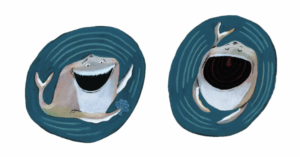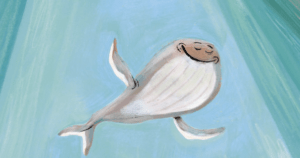Soren’s Seventh Song: A Q&A with Newly Minted Newbery Award Winner, Dave Eggers
Now to be fair, when I initially agreed to interview Dave Eggers about his brand new picture book Soren’s Seventh Song (out February 6th and illustrated by Mark Hoffman), he hadn’t yet won his brand new Newbery Award for The Eyes and the Impossible. Turns out, I was intrigued when the title was described to me as, “a deadpan take on creativity and persistence”, since that’s kind of my bag. Sure enough, when I read the book it was precisely that. An entire picture book about the process of . . . revision and editing!
Here’s the summary of the book. I warn you, it’s gonna hit hard for the authors amongst us:
“Soren, a young humpback whale, loves music but is tired of the dull, droning, endless songs that are frustratingly popular among the adult whales he knows. He has ideas for better songs: shorter, up-tempo tunes with snare drums and even maracas. Unfortunately, every time he shares his new tunes with his friends, he’s met with less than encouraging feedback and even a bit of discreet whale vomiting.
In this upbeat story of resilience and tenacity, Dave Eggers offers readers of all ages essential creative advice: your first drafts are probably terrible.”
Today, I talk with Dave Eggers about a strange little book about whales and, quite frankly, the creative process of editing (which, let’s face is, isn’t usually fun, but this book may be the rare exception):
ADVERTISEMENT
ADVERTISEMENT
Betsy Bird: Dave! Thanks so much for letting me take a deep dive into SOREN’S SEVENTH SONG. This marks an interesting mixing and melding of the different parts of your life. One cannot read this book and not think of it in terms of your 826 initiatives around the country. This book is essentially about the process of revision, after all. But where did you come up with the idea?

Dave Eggers: You know, I made the connection you did after the fact. We’ve been teaching the centrality of revision for 22 years now, and finally, I think I sublimated that idea into this book. But the first, superficial, thought I had for the book was when I read, about 5 years ago, a report about how humpack whales actually have “hit” songs — that for a period of months, whales all over the world will be singing the same song. That struck me as astonishing and kind of funny, and I thought maybe there’d be a young whale who wanted to make a shorter, and more jaunty, type of whale song. That was the original idea, though the revision part of it came quickly thereafter.
BB: The sheer number of humpback whale facts you’ve also included in the book is impressive. Is there any particular reason that you chose this specific animal as your hero? After all, these whales are hardly the only creatures to sing in the world. What’s the allure of the humpback for you?
DE: In the Bay Area, you’re reading about whale sightings every day, and I’ve seen quite a few in the Pacific myself (and washed up on the beach, unfortunately). I’m deeply fascinated by whales, and again, the idea that there are certain whalesongs that go in and out of fashion was so intrinsically appropriate for a book like this that humpbacks were the only appropriate protagonists.
BB: Years ago you wrote two picture books that were pretty clearly nonfiction (THIS BRIDGE WILL NOT BE GRAY and HER RIGHT FOOT). I want to talk a bit about what happens when we mix our truth with our fiction, and the interesting ways that these two supposedly separate genres can intersect. You’re an author who appears to enjoy playing by the rules. You don’t pass off your fiction as nonfiction. Hell, you seem to almost go out of your way in this book to clarify when one statement or another is true or untrue. Can you tell me a little about how you approach a book where so much of it is so clearly real and so much of it is clearly made up?

DE: You’re right, in that I think if an author explains their methodology and approach, the reader can settle in and enjoy it without having to guess what’s real and not-real. In this case, in the book I start with some whale facts — about their singing, chiefly — and then have that moment where I tell the reader that everything after that certain page is made up. It was key to explain the weird whale facts, so the reader knows that the premise is somewhat possible.
BB: It seems to me that the secret hero of this book is Hans, Soren’s friend. He listens to Soren’s song over and over and even though most of the time it makes him want to vomit, he offers just enough encouragement to his friend to keep him working on it. So the logical question I have for you today is who, in your own life, is your own “Hans”?
DE: Hans is a real mensch, because he tells Soren the truth. It’s hard to find that person who expects a lot of your work, but is also candid and constructive enough to tell you when you can do better. Hans does that for Soren, even while trying to hide the fact that some of Soren’s songs make him vomit (though he does it discreetly).
That reminds me of another 826 Valencia principle, which is that when we read a student’s first draft, we always say some version of, “This is gonna be great.” The student can then relax, knowing that after that, it’s just a process of settling into stages of revision. The crucial mistake we all make as young writers, and sometimes as mentors to these young writers, is to either think first drafts are unsalvageable, or say that they’re perfect. Neither is likely. Both leads to laziness and disappointment.

But I didn’t answer the end of your question. For me, my wife Vendela, also a writer, gets stuck reading my first drafts. Over the years I’ve also shown quite a few to my retired high school teacher, Peter Ferry, who became a novelist after retiring, and has a beautiful way of being both encouraging and tough. And then there are always book-specific readers — that is, a certain reader who I’d hope would respond to that particular book. With Soren, those readers were members of our Young Editors Project — in this case middle-schoolers who, I hoped, would go along with a story that’s not quite a picture book and not quite a chapter book.
BB: I’d just like to thank you for including a reference to a theremin in your picture book. To the best of my knowledge you are the first person to do so (though I cannot deny that there’s an outside chance that Edward Gorey may have done it first). I assume that its inclusion made it through many drafts of this particular book. Come to think of it, how many drafts did this book go through? Revising a book on revision sounds particularly complex.
ADVERTISEMENT
ADVERTISEMENT
DE: I wrote the first draft about 5-6 years ago, and then put it aside. Then after a year I took it out again, revised it, improved it, and showed it to a few publishers, who passed on it. Then I put aside again. Finally, about 3 years ago, I dug it out it again, read it cold, and was surprised to find that I still liked it a lot. That’s pretty rare. When you come back to something years later, and like it just as much, that’s a rare feeling. And it makes it far easier to make those last, and best, edits, because you’re seeing it from a very detached perspective. So I went through another half-dozen drafts between then and the publication of the book. All in all, it might have been 10-12 drafts. Which is about average for me.

BB: Were you aware of the art of Mark Hoffmann before he came to your book? How do you feel about the final art?
DE: Cameron & Co found Mark, and the collaboration couldn’t have been smoother and happier. He brought such palpable joy and personality to the whales and other creatures, and his color palette was very bold.
BB: And finally, what do you have coming out for kids in the future?
DE: I’m finishing a very important story about a cat who does excellent plumbing at reasonable rates. The tentative title is My Cat Is an Excellent Plumber.
Doggone it. When that man ends an interview he damn well drops the mic along the way. I’d like to thank Dave for taking the time to answer my questions, and thanks too to Mary Marolla and the folks at Abrams for setting this all up.
Soren’s Seventh Song is out February 6th in good bookstores and libraries everywhere. Seek it out and learn a thing or two about first, second, third, and even sixth drafts.
Filed under: Interviews
About Betsy Bird
Betsy Bird is currently the Collection Development Manager of the Evanston Public Library system and a former Materials Specialist for New York Public Library. She has served on Newbery, written for Horn Book, and has done other lovely little things that she'd love to tell you about but that she's sure you'd find more interesting to hear of in person. Her opinions are her own and do not reflect those of EPL, SLJ, or any of the other acronyms you might be able to name. Follow her on Twitter: @fuseeight.
ADVERTISEMENT
ADVERTISEMENT
SLJ Blog Network
Name That LEGO Book Cover! (#53)
Exclusive: Vol. 2 of The Weirn Books Is Coming in October | News
Fighting Public School Book Bans with the Civil Rights Act
North Texas Teen Book Festival 2024 Recap
ADVERTISEMENT







